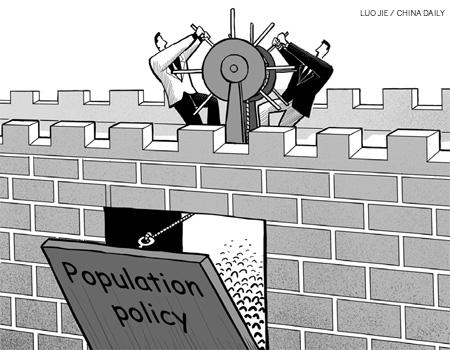According to Professor Mu Guangzong from Institute of Population Research, Peking University, China needs an immediate change to allow couples to have two children.
Peking University, Mar. 21, 2011: Recent years have seen Chinese people debating whether the national family planning policy should be relaxed. At the just concluded annual session of the National People's Congress, some deputies suggested loosening the policy to allow couples to have a second child if either of them is the only offspring of his or her parents.
The family planning policy was introduced three decades ago. The resultant sharp decline in fertility rate and rapid demographic changes, especially the lowering of the birth rate, has yielded great benefits. The fall in birth rate has helped the government and families provide better medical care to children and child-bearing women. Yet uncertainty over the family planning policy persists.
After following a strict family planning policy for 30 years, China now faces a demographic imbalance. Some people argue that the change from high to low birth rate has lowered the child dependency ratio. But they do so because they confuse demographic bonus with demographic window of opportunity.
Demographic bonus, in essence, refers to the economic growth and social benefits brought about by human resources development - and the fact that it can be sustained. Demographic window, on the other hand, refers to the period during a country's demographic evolution when the proportion of its reproductive-age population is particularly prominent. The much-lauded low child dependency ratio just reflects the demographic window. Worse, the aged dependency ratio is already on the rise thanks to the growing proportion of senior citizens.
In this sense, the family planning policy compromises the long-term demographic balance to ease short-term population pressure and, in the process, trigger other population-related problems, including increasing pressures of pension payments, gender imbalance and labor shortage.
Devised in the times of planned economy, the policy has become outdated. The government should have changed it in the 1990s when the country started experiencing negative natural population growth.
A country's fertility rate should be moderate in every sense of the term. But it should vary according to the size and proportion of reproductive-age people to the total population. After decades of experiments, we have realized that the size of the population is not the only demographic problem the country faces.
Having a balanced population development is more important and challenging than curbing the size of the population. Hence, China should now try to reach a moderate fertility rate.
Over the past three decades, the strict implementation of the family planning policy has upset many people, especially farmers. Besides, the policy has resulted in an unbalanced sex ratio and gender inequity, and single-child families have aggravated the problem of senior citizens' upkeep. All this calls for a change in the family planning policy.
To achieve a balanced population development in the long run, the government should take measures to ensure that the population maintains a moderately low fertility rate. Proper education and family planning consultancy have to be integral parts of any measure that is taken. But the family planning policy should be open to changes, especially after a moderately low fertility rate is realized.

The current average fertility rate in the country is between 1.4 and 1.8. The rate will probably continue to fall given the rapid urbanization and modernization the country is going through.
The continued decline in the fertility rate results mainly from the economic, social and cultural evolution of low fertility. Three decades of reform and opening-up have resulted in many demographic changes and a falling fertility rate.
As the message from the 1974 World Population Conference in Bucharest said: "Development is the best contraceptive."
Once the total fertility rate is below 1.3, it will be more difficult to encourage births than to control. A moderate fertility rate is adjustable, and conducive to social and economic development.
From the perspective of sustainable population development, the total replacement fertility rate, which indicates whether childbearing-age couples can have enough children to replace themselves, should be maintained at 2.1. To achieve that, China should relax its family planning policy and allow every couple to have two children. This is a sustainable rate. In fact, allowing couples to have two children would stabilize the fertility rate around 1.8, because a percentage of the couples would still prefer having a single child or no child at all, and 10 to 15 percent of all couples in the country suffer from sterility.
All this calls for the government to ease the family population policy sooner than later. Besides, the government should combine family planning with social planning to get optimum benefit from population development. More importantly, it should take measures to ensure that the country reaches a moderate fertility rate and maintains a balanced demographic structure.
And its investment in family planning should be aimed at achieving all-round development both for society and individuals.
The other important task for the government is to keep modifying its family and social planning so that it can offer quality service to newborns and their parents, especially mothers, and let every reproductive-age couple decide the number of children they want to have.
Extended Reading:
Family policy relaxed in Beijing for more couples
Written by: Mu Guangzong
Edited by: Arthars
Source: China Daily





